Dr.Teruo Higa’s
Living A Dream
- 2024
- 2023
- Oct:#187 Supermassive Typhoon No.6 and Subsequent Typhoon No. 11
- Sep:#186 Massive Typhoon No.6 that swallowed the Ryukyu Islands Graviton barrier
- Sep:#185 August 8th is World “EM Mudball Day”
- Aug:#184 A disease-free life depends on the health of the intestinal microbiome.
- Jul:#183 Trial and Error at the Blue-Sky Palace, Part 3
- Jun:#182 Trial and Error at the Blue-Sky Palace, Part 2
- Apr:#181 Trial and Error at the Blue-Sky Palace
- Mar:#180 Ala Wai Canal Cleanup Project in Waikiki, Hawaii
- Feb:#179 High-Yield, High-Quality Rice Production Using EM
- Feb:#178 The Progress the "Soil Preparation Workshop" of the Oishi 3-chan Club (Part 2)
- Jan:#177 Organic Farming Instructional Manual Using EM
- 2022
- Nov:#176 The Typhoon Situation in Okinawa in 2022
- Sep:#175 Third-Party Verification of the Graviton barrier in Okinawa Part-2
- Sep:#174 Third-Party Verification of the Graviton barrier in Okinawa
- Aug:#173 Ecosystem Changes Observed in Okinawa in 2021 Part-5
- Jun:#172 Ecosystem Changes Observed in Okinawa in 2021 Part-4
- May:#171 Ecosystem Changes Observed in Okinawa in 2021 Part-3
- Apr:#170 Ecosystem Changes Observed in Okinawa in 2021 Part-2
- Mar:#169 Koizumi Farm in Kamakura Continues to Evolve
- Feb:#168 Ecosystem Changes Observed in Okinawa in 2021 Part-1
- 2021
- Dec:#167 Enjoying EM Technology While Enriching the Local Ecosystem
- Nov:#166 A Case Study of the Use of EM in a Next Generation Free School in Tune with the Cycles of Nature
- Oct:#165 Typhoon conditions and flowers in Okinawa from August to October
- Sep:#164 Re-learning the origins of river purification using EM Cleaning up the Dairyuji River in Senami (Murakami City, Niigata Prefecture)
- Aug:#163 Measures Against Natural Disasters and Re-learning the Starting Point of EM
- Jul:#162 Summary of FFC (Foods for Children) Okinawa Forum 2021
- Jun:#161 Restoring the Vigor of an Old Tree and Purifying the Environment with EM Technology That Even an Amateur Can Do
- May:#160 The Public is Beginning to Recognize the Use of EM Smokeless Carbonizers
- Apr:#159 EM Hado (EM Graviton) that exerts quantum superposition effect over time
- Mar:#158 Virus-free Okinawan Plants Through Use of an EM Graviton Barrier
- Jan:#157 Enjoyable Farming for Self-Sufficiency that Even Amateurs Can Do
- 2020
- Dec:#156 EM quantum energy effect occurring in Okinawa
- Nov:#155 Implementing EM graviton farming as a flood countermeasure for apple orchards
- Oct:#154 The Latest Book on the Practical Uses of EM "You Are the One Who Draws Out the Power of Microorganisms," by Chizuko Nomoto
- Sep:#153 Application of EM technology to long periods of rain, lack of sunshine, storms, heavy rains, etc.
- Aug:#152 EM application in Kitanakagusuku village plant waste recycling yard
- Jul:#151 Natural Disaster Countermeasures Using EM Technology: Part 2
- Jul:#150 Natural Disaster Countermeasures Using EM Technology
- May:#149 How to make your home and workplace an energy spot by living a complete EM lifestyle: creating the ultimate source of health and environmental purification
- Apr:#148 EM, Viruses and the Pandemic
- Apr:#147 New agriculture applying quantum mechanics Part 2
- Apr:#146 New agriculture applying quantum mechanics
- Apr:#145 Wonderful EM Miracle
- 2019
- Nov:#144 The movie “Revival II” and the reality of Fukushima
- Oct:#143 Boundary dome and foliar spraying of EM・X GOLD and EM 3
- Oct:#142 Kirakira (Sparkling) Summer Vegetable Festa in 2019
- Aug:#141 Excessive salt inevitably causes salt damage
- Jul:#140 Diverse applications of charcoal Part 3
- Jun:#139 Diverse applications of charcoal Part 2
- Jun:#138 Diverse applications of charcoal
- Jun:#137 Purification power of salt
- May:#136 The degree of soil contamination is a reflection of the microflora
- May:#135 Definitive use of EM barriers to deal with typhoons
- May:#134 Implementing authentic Nature Farming
- May:#133 How to enhance healthy Hado (wave energy) by EM
- May:#132 Eating Dirt (Soil)
- May:#131 Hado (Wave energy) involved in health
- May:#130 Reaffirming EM technology to realize the essence of agriculture
- May:#129 The 2nd EM Producer Networking Meeting
- Apr:#128 Understanding the application of seawater and salt in crop cultivation
- Apr:#127 Prevention of Disasters by EM Technology
- Mar:#126 Quantum overlay effective utilization of EM
- Jan:#125 EM Disaster Recovery Support Projects in 2017
- 2018
- 2017
- Aug:#121 Escape from conventional agricultural traps
- Jul:#120 Limitation and important caveats regarding utilization of salt
- Jun:#119 EM Technology to Break Through the Limits of Pesticide-Free Strawberries
- May:#118 Application of barriers using EM rectification force
- Apr:#117 The 1st EM Produce Growers' Networking Conference
- Mar:#116 Sumizo kun: The Ultimate Versatile Carbonization Equipment
- Feb:#115 How to make and use simple carbonized and rectified ash
- Jan:#114 Achievements of 2016
- 2016
- Dec:#113 Definitive Measures Against Typhoons
- Nov:#112 International Conference on Universal Village
- Oct:#111 90% of Your Body is Microbes
- Sep:#110 Disaster Countermeasures Using EM
- Aug:#109: Changes in the Natural Environment by EM Barrier Domes in Okinawa
- Jul:#108: Multi-purpose Utilization of Activated EM with Seawater and Salt
- Jun:#107: Marine Day, when EM Mudballs and Activated EM are Applied Throughout Japan
- May:#106: The Function of EM and Gravitational Waves–Part 3
- Apr:#105: The Function of EM and Gravitational Waves–Part 2
- Feb:#104: The Function of EM and Gravitational Waves
- Feb:#103: The Importance of Phototrophic Bacteria in EM
- 2015
- Dec:#102: Results of Environmental Forum "Utsukushima EM Paradise" 2015
- Nov:#101: Environmental Forum "Utsukushima EM Paradise" 2015
- Oct:#100: A New Phase of Limit Breakthrough Using EM
- Sep:#99: A New Phase of Limit Breakthrough through EM
- Aug:#98: The Tokyo Bay Area Began Creating a Truly Livable Hometown
- Jul:#97: Rectifying Effects of EM
- Jun:#96: Lake Suwa Sousei lecture
- May:#95: In Order to Further Ensure Limit Breakthrough
- Apr:#94: Theatrical Release of the Documentary Film SOSEI-Revival to Enlighten People on the New Possibilities of Microorganisms
- Mar:#93: What Underlies Limit Breakthrough (Part 2)
- Feb:#92: EM Functions to Break Through Limits
- Jan:#91: At the Start of 2015
- 2014
- Dec:#90: Looking Back at 2014
- Nov:#89: Shikoku EM FESTA 2014, Virtuous Circle Conference in Matsuyama, Ehime Prefecture
- Oct:#88: Using EM to Deal with Weather Disasters (Part 2)
- Sep:#87: Current Status of Radioactivity Measures Using EM in Fukushima
- Aug:#86: APNAN (Asia Pacific Natural Agriculture Network) 25th Anniversary Conference in 2014
- Jul:#85: Using EM to Deal with Weather Disasters
- Jun:#84: Substantial Improvement of Soil
- May:#83: The Energy Rectification Force of EM
- Apr:#82: The Annual 18th EM Technology Exchange Meeting and Tohoku Conference in Shichigahama
- Mar:#81: Salmon going upstream in Kitaura (Kasumigaura)
- Feb:#80: The Microbiome Again
- Jan:#79: Inauguration of the Federation of Diet Members Who Use and Apply Effective Microorganisms
- 2013
- Dec:#78: Receiving an Honorary Doctoral Degree from Rajamangala University of Technology in Thailand
- Nov:#77: The Use of EM in School Education in Bhutan
- Oct:#76: Well of Bonding
- Sep:#75: The Background to EM Not Being Employed by Public Institutions to Deal with Radiation
- Aug:#74: Dealing with Disaster: Using EM in Crisis Management
- Jul:#73: EM Events on Ocean Day
- Jun:#72: Using EM to Deal With Heat Stroke and Summer Heat Fatigue
- May:#71: An EM Model Town in Malaysia
- Apr:#70: Steps the Japanese Government is Taking to Deal with Radiation: Are They Really Safe?
- Mar:#69: EM Group Disaster Reconstruction Aid Project in Fukushima
- Feb:#68: EM and Microbiomes (Microbial Flora)
- Jan:#67: A Necessary Evil is Still Evil
- 2012
- Dec:#66: The 17th National EM Technology Exchange Conference / Hokkaido Conference in Sapporo
- Nov:#65: EM Forum 2012 in Okinawa and the Environmental Forum in Fukushima
- Oct:#64: 2012 EM Forum
- Sep:#63: A New Earth Saving Revolution
- Aug:#62: The Asahi Newspaper’s Misguided Reports About EM
- Jul:#61: Using EM in Radioactive Contamination Measures in Fukushima Prefecture
- Jun:#60: The Effects of Using EM to Inhibit the Absorption of Radioactivity as Confirmed in Fukushima
- May:#59: Recovery Support for the Great East Japan Earthquake
- Apr:#58: The Royal Kingdom of Thailand, in which EM Functions as a Set Government Policy
- Mar:#57: Report on the Measures Taken by Kingdom of Thailand Using EM to Deal with Polluted Water
- Feb:#56 EM™ as Part of National Policy in Thailand to Deal with Sanitation Issues Resulting from the Flood of 2011
- Jan:#55 The Law of Syntropy (Revitalization)
- 2011
- Dec:#54 EM Forum 2011
- Nov:#53 Shikoku EM Festa 2011- Zenjunkan no Wa (Virtuous Circle) Tokushima Conference in Naruto -
- Oct:#52 The Mystery of Interim Safety Values for Radioactive Material
- Sep:#51 Successful Radiation Countermeasures Using EM
- Aug:#50 Events on Sea Day in which EM Mud Balls are Thrown into the Water and Activated EM is Applied.
- May:#47 Dealing with the Damage Caused by the Eastern Japan Earthquake
- Apr:#46 Eastern Japan Earthquake
- Mar:#45 The 16th National EM Technology Hokuriku Conference in Fukui
- Feb:#44 More Thoughts on Avian Influenza and Foot-and-Mouth Disease
- Jan:#43 Happy New Year!
- 2010
- Dec:#42 Shikoku EM FESTA 2010・Zenjunkan no wa (Virtuous Circle) Fellowship Conference in Tobe, Ehime Prefecture
- Nov:#41 EM Forum 2010
- Oct:#40: My Thanks to the EM™ Volunteers Who Helped in the Fight Against Foot-and-Mouth Disease in Miyazaki Prefecture
- Sep:#39 International EM Mud Ball Day
- Jul:#37 Poland EM Forum 2010
- Jun:#36 EM Countermeasures Against Foot-and-Mouth Disease
- May:#35 Abnormal Weather
- Apr:#34 EM Activities in Thailand: Finding Solutions to the Challenges Facing the Nation
- Mar:#33 New Developments in the Evolution of EMTM in Thailand
- Feb:#32 Results Starting to Be Seen at the Mikasa Project
- Jan:#31 Towards an EM-Use Society
- 2009
- Dec:#30 EM Summit
- Nov:#29 The System in Penang State in Malaysia that Made the World EMTM Mudball Day a Success
- Oct:#28 The "World EM Mudball Day" in Malaysia
- Sep:#27 Validating EMTM Medicine: Case Study Reports from EM Users 2009. (Part 3)
- Sep:#26 Validating EMTM Medicine: Case Study Reports from EMTM Users 2009. (Part 2)
- Jul:#25 Validating EMTM Medicine: Case Study Reports from EMTM Users 2009. (Part 1)
- Jun:#24 Activities to Disseminate EM-Focused Nature Farming in China
- May:#23 Use of EMTM in Response to Swine Flu
- Apr:#22 Using EM to Solve Public Administrative Costs
- Mar:#21 Reaffirming the Versatility of EM
- Jan:#20 The Beginning of a New Era
- 2008
#191 Steadily Evolving EM Nature Farming Method at the Blue Sky Palace

The pandemic caused by the coronavirus forced us to make changes in our EM promotion activities. Various lectures and conferences have changed from in-person format to using Zoom, which has significantly reduced costs and time, but also gave us the opportunity to engage in fundamental changes.
EM can be quite versatile if its quantum properties are utilized, but common sense persists in believing that the “all-powerful" does not exist” and is a fake idea.
EM is now used all over the world in the fields of agriculture and the environment. The unimaginable EM bashing of the past, which insisted that EM is "pseudo-science,” has disappeared.
The key to taking advantage of EM’s quantum mechanical versatility is to use it in a way that improves its functionality throughout the year. In other words, we must not only provide lectures and training sessions, but also provide on-site demonstrations of its use.
The creation of the Universal Village model being promoted by the EM Research Organization and United Networks for Earth Environment (U-net), a nonprofit organization, is an advanced development of EM activities. This is based on the vital need for a Copernican-level reform, a change from the conventional use of EM in conventional farming methods to a method of farming that is adapted to the versatility of EM.
The most important thing is that the soil microbiota must be EM-enhanced and managed in a stable manner over a period of time. To do this, spread a thin, wider layer of organic matter such as weeds, leaves, kitchen waste, etc., over the soil, and then spray activated EM liquid diluted with water to 1:50-100 and apply it on top until the entire area is moistened. At the same time, continue no-till continuous cultivation. Even in cold winters you still can improve the microbial flora by applying 50 to 100 kg of salt and 10 to 500 liters of activated EM liquid per 10 ares before the snow piles up.
At Blue Sky Palace, as I previously introduced (see No. 182) I have created a permanent planting squares with a barrier function and I am continuously growing tomatoes, cucumbers, eggplants, etc., and am committed to no-tillage. Potatoes and other crops can be cultivated by simply applying EM Bokashi and activated EM liquid in the furrows and putting potatoes in, then covering them with about 5 cm of weeds.
Photo 1 shows the tomatoes introduced in article No. 189. I have already harvested over 500 of them, and they have grown into a hedge of tomatoes.
Lettuce is planted at the base of tomato plants, and as shown in Photo 3, old leaves are removed and spread on the surface as shown in Photo 3.
EM can be quite versatile if its quantum properties are utilized, but common sense persists in believing that the “all-powerful" does not exist” and is a fake idea.
EM is now used all over the world in the fields of agriculture and the environment. The unimaginable EM bashing of the past, which insisted that EM is "pseudo-science,” has disappeared.
The key to taking advantage of EM’s quantum mechanical versatility is to use it in a way that improves its functionality throughout the year. In other words, we must not only provide lectures and training sessions, but also provide on-site demonstrations of its use.
The creation of the Universal Village model being promoted by the EM Research Organization and United Networks for Earth Environment (U-net), a nonprofit organization, is an advanced development of EM activities. This is based on the vital need for a Copernican-level reform, a change from the conventional use of EM in conventional farming methods to a method of farming that is adapted to the versatility of EM.
The most important thing is that the soil microbiota must be EM-enhanced and managed in a stable manner over a period of time. To do this, spread a thin, wider layer of organic matter such as weeds, leaves, kitchen waste, etc., over the soil, and then spray activated EM liquid diluted with water to 1:50-100 and apply it on top until the entire area is moistened. At the same time, continue no-till continuous cultivation. Even in cold winters you still can improve the microbial flora by applying 50 to 100 kg of salt and 10 to 500 liters of activated EM liquid per 10 ares before the snow piles up.
At Blue Sky Palace, as I previously introduced (see No. 182) I have created a permanent planting squares with a barrier function and I am continuously growing tomatoes, cucumbers, eggplants, etc., and am committed to no-tillage. Potatoes and other crops can be cultivated by simply applying EM Bokashi and activated EM liquid in the furrows and putting potatoes in, then covering them with about 5 cm of weeds.
Photo 1 shows the tomatoes introduced in article No. 189. I have already harvested over 500 of them, and they have grown into a hedge of tomatoes.
Lettuce is planted at the base of tomato plants, and as shown in Photo 3, old leaves are removed and spread on the surface as shown in Photo 3.
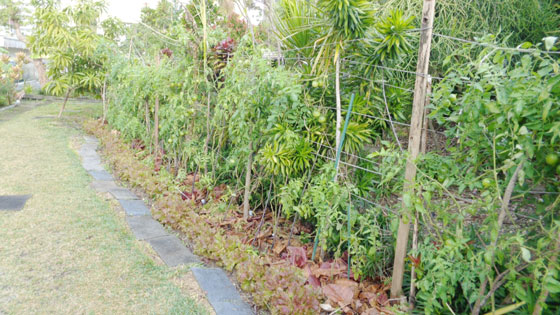
On the far left is leaf lettuce, and the inside is covered with fallen leaves.
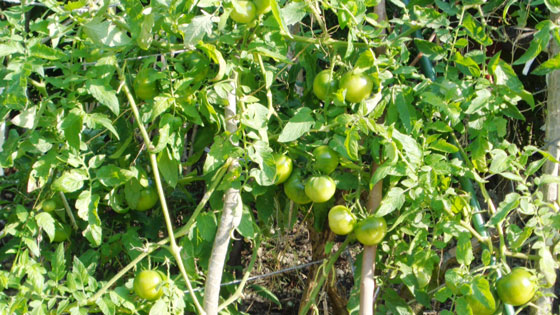
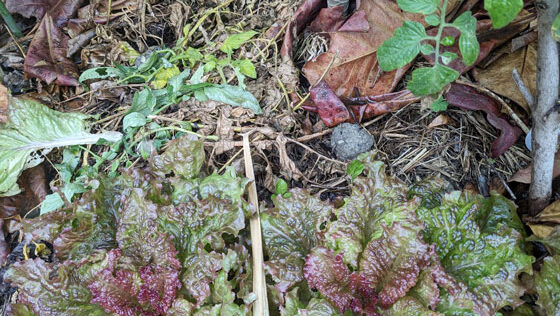
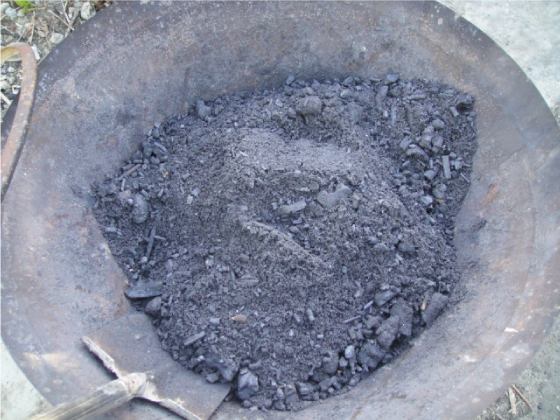
The ash is mixed with salt, and the moisture is adjusted with activated EM liquid to make balls. If you do not have rectified ash, use EM rectified charcoal (How to make rectified charcoal using a smokeless carbonizer) or EM Gravitron charcoal as a substitute.
Reference: Former Web Ecopure (now “New Living with the Dream”): Application of the Diversity of Charcoal (No. 138) and Application of the Diversity of Charcoal 2 (No. 139).
If you apply this ash regularly, it will become like the perennials seen in Photo 5.
Reference: Former Web Ecopure (now “New Living with the Dream”): Application of the Diversity of Charcoal (No. 138) and Application of the Diversity of Charcoal 2 (No. 139).
If you apply this ash regularly, it will become like the perennials seen in Photo 5.
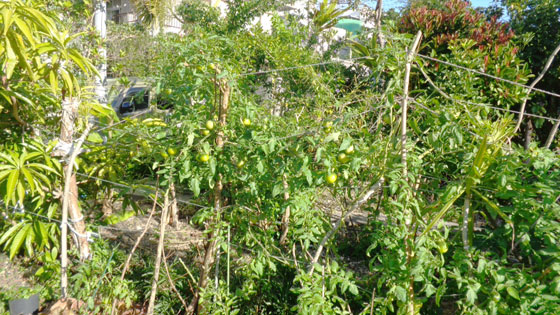
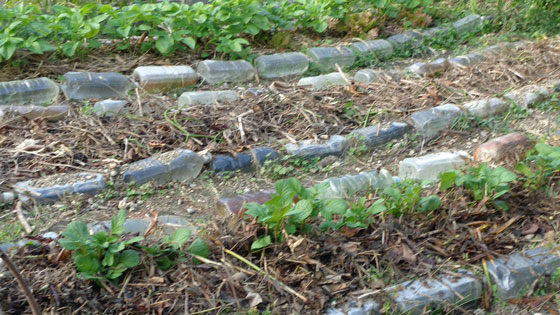
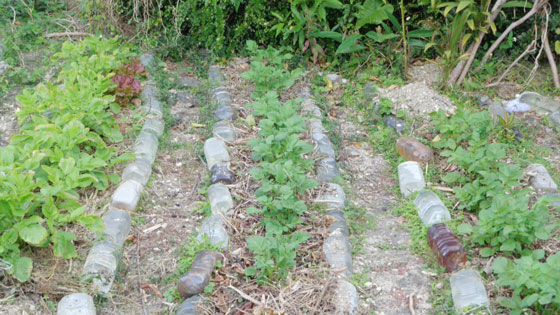
Photo 6: The center row in Photo 6 is an experiment in self-seeding potatoes. At the same time as planting, I applied a 5-6 cm layer of weed mulch.
Photo 7 shows the condition after one month. This method can be applied as an intercrop after harvesting sugarcane, and as with the cultivating method of simply putting potatoes on the soil with covering mulch without digging holes, you can harvest them without digging them.
Photo 7 shows the condition after one month. This method can be applied as an intercrop after harvesting sugarcane, and as with the cultivating method of simply putting potatoes on the soil with covering mulch without digging holes, you can harvest them without digging them.
Flowers and birds in Okinawa after Typhoon No. 6
I have already reported on Typhoon No. 6 and how the all the plants recovered very quickly afterwards, and there are many realities that, based on past experience, should be impossible (since it usually takes 2 to 3 years for recovery), and here I would like to introduce some of them. As always, a variety of stray birds are coming to Okinawa this winter. Groups of cormorants are also gradually growing larger, proof of abundant food sources here.
Flowers of Silk floss tree color Yagaji Island in Nago City
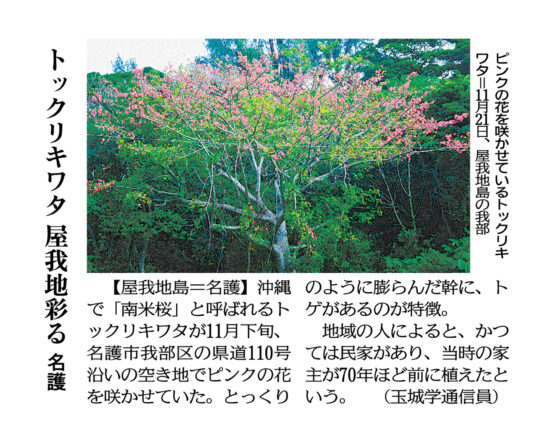
Okinawa Times, December 21, 2023
Yagaji Island, Naha City: In late November the pink flowers of the silk floss tree, called the "South American cherry tree” in Okinawa, was blooming in a vacant lot along Prefectural Route 110 in Gabe Ward, Nago City.
The tree is characterized by thorns and a distinctive trunk, which bulges out like a sake server bottle. According to a local resident, there used to be a private house there, and the owner of the house planted the tree about seventy years ago.
(Reported by Manabu Tamaki)
Yagaji Island, Naha City: In late November the pink flowers of the silk floss tree, called the "South American cherry tree” in Okinawa, was blooming in a vacant lot along Prefectural Route 110 in Gabe Ward, Nago City.
The tree is characterized by thorns and a distinctive trunk, which bulges out like a sake server bottle. According to a local resident, there used to be a private house there, and the owner of the house planted the tree about seventy years ago.
(Reported by Manabu Tamaki)
Butterflies gather at the Ward Chief’s House in Ogane Ward, in Ogimi Village
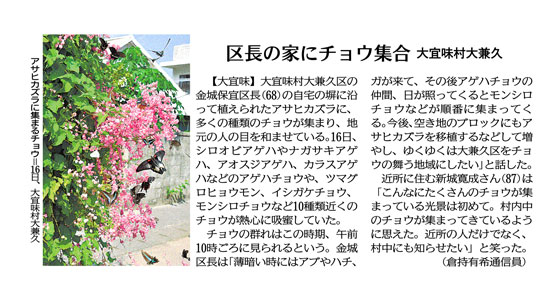
October 16, in Ogane Ward, Ogimi Village
Okinawa Times, October 24, 2023
Many types of butterflies are gathering on the Asahikazura, Mexican Creeper, planted along the fence of the house of Yasunori Kinjo, 68, the head of Ogane Ward of Ogimi Village, Okinawa Prefecture, and this has attrcated the attention of local people. On the 16th, nearly ten types of butterflies were eager sucking nectar. These include swallowtail butterflies such as the White-throated Swallowtail, the long-tailed Swallowtail, the Blue-throated Swallowtail, and the Crow Swallowtail, as well as the Black-bellied Fritillary Butterfly, the Cyrestis thyodamas, and the Monarch Butterfly. At this time of year the flocks of butterflies can be seen around 10 am. Mr. Kinjo said, “When it’s dark, horseflies, bees, and moths come, followed by swallowtail butterflies, and when the sun shines, cabbage butterflies and other butterflies gather in turn. In the future, I hope to increase the number of these butterflies by transplanting Mexican Creeper to blocks of vacant land, and eventually turn Ogane Ward into an area where butterflies can be seen fluttering together." Mr. Hironari Shinjo, 87, who lives nearby, said, “I have never seen so many butterflies gathered in one place. It seems as if butterflies from all over the village were gathering here. I want to let not only my neighbors but the whole village know about it,” he laughed. (Reported by Yuki Kuramochi)
Many types of butterflies are gathering on the Asahikazura, Mexican Creeper, planted along the fence of the house of Yasunori Kinjo, 68, the head of Ogane Ward of Ogimi Village, Okinawa Prefecture, and this has attrcated the attention of local people. On the 16th, nearly ten types of butterflies were eager sucking nectar. These include swallowtail butterflies such as the White-throated Swallowtail, the long-tailed Swallowtail, the Blue-throated Swallowtail, and the Crow Swallowtail, as well as the Black-bellied Fritillary Butterfly, the Cyrestis thyodamas, and the Monarch Butterfly. At this time of year the flocks of butterflies can be seen around 10 am. Mr. Kinjo said, “When it’s dark, horseflies, bees, and moths come, followed by swallowtail butterflies, and when the sun shines, cabbage butterflies and other butterflies gather in turn. In the future, I hope to increase the number of these butterflies by transplanting Mexican Creeper to blocks of vacant land, and eventually turn Ogane Ward into an area where butterflies can be seen fluttering together." Mr. Hironari Shinjo, 87, who lives nearby, said, “I have never seen so many butterflies gathered in one place. It seems as if butterflies from all over the village were gathering here. I want to let not only my neighbors but the whole village know about it,” he laughed. (Reported by Yuki Kuramochi)
Sagaribana blooming out of season at Mr. Uema's house in Nago
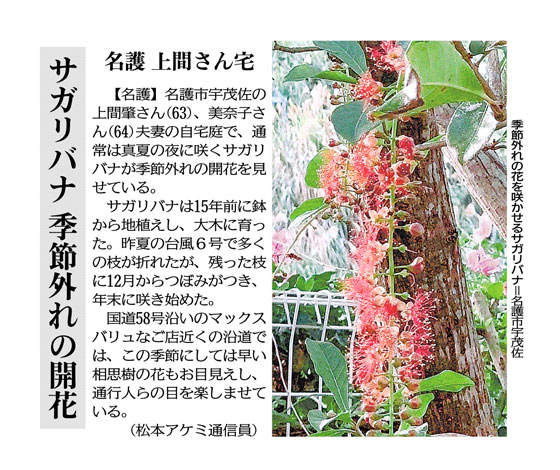
Okinawa Times, January 16, 2024
In the garden of Mr. Hajime Uema, 63, and his wife Minako, 64, in Umusa, Nago City, the Sagaribana, which usually blooms at night in mid-summer, is blooming out of season. The Sagaribana was transplanted from a pot fifteen years ago and has grown into a large tree. Many of the branches broke during Typhoon No. 6 last summer, but buds started forming on the remaining branches in December, and they began blooming at the end of the year. Along National Route 58 near the MaxValu Nago store, the flowers of the Acacia tree also made an early appearance for the season, pleasing the eyes of passerby.
(Reported by Akemi Matsumoto)
In the garden of Mr. Hajime Uema, 63, and his wife Minako, 64, in Umusa, Nago City, the Sagaribana, which usually blooms at night in mid-summer, is blooming out of season. The Sagaribana was transplanted from a pot fifteen years ago and has grown into a large tree. Many of the branches broke during Typhoon No. 6 last summer, but buds started forming on the remaining branches in December, and they began blooming at the end of the year. Along National Route 58 near the MaxValu Nago store, the flowers of the Acacia tree also made an early appearance for the season, pleasing the eyes of passerby.
(Reported by Akemi Matsumoto)
Pink Ipe flowers are blooming at private residences in Okita and Nakayama, Nago City
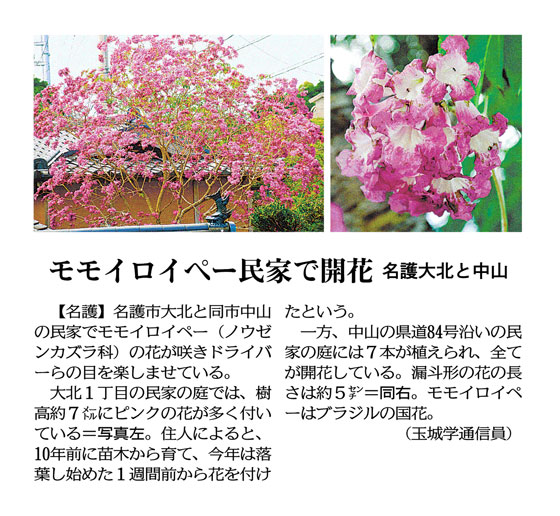
Okinawa Times, January 14, 2024
Pink Ipe flowers (Bignoniaceae) are blooming at private residences in Okita and Nakayama, Nago City, and delighting the eyes of drivers. In the garden of a home in Okita 1-chome, a tree about seven meters tall is full of pink flowers. (Photo left). According to the resident, he grew the tree from a sapling ten years ago, and this year it started blooming a week before the leaves began to fall. Meanwhile, seven trees planted in the garden of a home along Prefectural Route 84 in Nakayama are all in full bloom now. The funnel-shaped flowers are about 5 cm long (Photo on the right). Pink Ipe is the national flower of Brazil.
(Reported by Manabu Tamaki)
Pink Ipe flowers (Bignoniaceae) are blooming at private residences in Okita and Nakayama, Nago City, and delighting the eyes of drivers. In the garden of a home in Okita 1-chome, a tree about seven meters tall is full of pink flowers. (Photo left). According to the resident, he grew the tree from a sapling ten years ago, and this year it started blooming a week before the leaves began to fall. Meanwhile, seven trees planted in the garden of a home along Prefectural Route 84 in Nakayama are all in full bloom now. The funnel-shaped flowers are about 5 cm long (Photo on the right). Pink Ipe is the national flower of Brazil.
(Reported by Manabu Tamaki)
A spectacular sight: 800 cormorants gathered on Goga Beach, Nago City
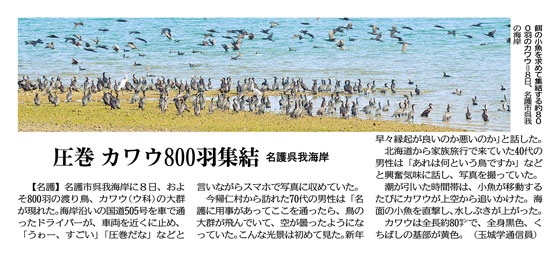
Okinawa Times, January 13, 2024
On the 8th, a large flock of about 800 migratory birds, cormorants (family Cormorantidae), appeared on Goga Beach in Nago City. A driver passing by on National Route 505 along the coast stopped his car and took pictures with his cell phone. “Wow, this is amazing!” was his reaction.
A man in his 70s who visited Nakijin Village said, “I had an errand in Nago and was passing by here when I saw a large flock of birds flying. There were so many it was like the sky had clouded over. I had never seen such a sight before. I don’t know whether this is a good luck signs or bad luck for the New Year.”
A man in his 40s who was on a family trip from Hokkaido excitedly asked, “What kind of bird is that?” and kept taking pictures.
When the tide was low, the cormorants dove from the sky to chase the small fish as they moved. They hit the small fish on the surface of the sea, sending up splashes. The cormorants are approximately 80 centimeters long, all black, with yellow at the base of their beaks.
(Reported by Manabu Tamaki)
On the 8th, a large flock of about 800 migratory birds, cormorants (family Cormorantidae), appeared on Goga Beach in Nago City. A driver passing by on National Route 505 along the coast stopped his car and took pictures with his cell phone. “Wow, this is amazing!” was his reaction.
A man in his 70s who visited Nakijin Village said, “I had an errand in Nago and was passing by here when I saw a large flock of birds flying. There were so many it was like the sky had clouded over. I had never seen such a sight before. I don’t know whether this is a good luck signs or bad luck for the New Year.”
A man in his 40s who was on a family trip from Hokkaido excitedly asked, “What kind of bird is that?” and kept taking pictures.
When the tide was low, the cormorants dove from the sky to chase the small fish as they moved. They hit the small fish on the surface of the sea, sending up splashes. The cormorants are approximately 80 centimeters long, all black, with yellow at the base of their beaks.
(Reported by Manabu Tamaki)
A stray red-crested pochard in Nago Fishing pond at Neo Park
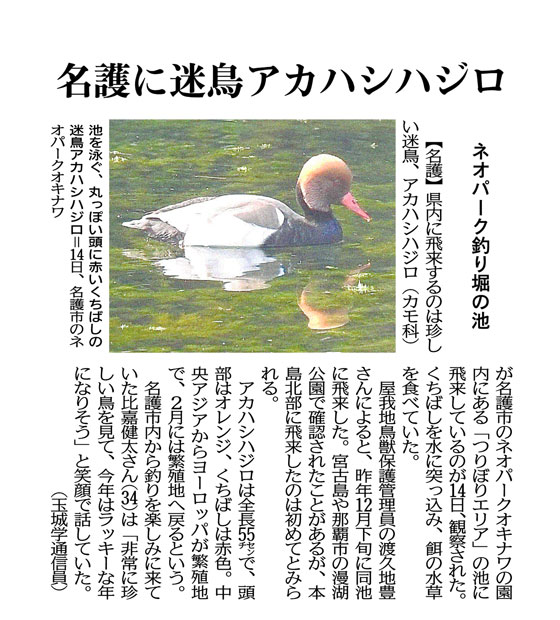
Okinawa Times, January 17, 2024
On the 14th, a red-crested pochard (family Anatidae), a bird that rarely strays into Okinawa Prefecture, was observed flying into a fishing pond at the “Neo Park Okinawa” in Nago City. It was sticking its beak in the water, feeding on aquatic plants.
According to Mr. Yutaka Toguchi, a Yagaji wildlife conservation manager, the bird flew to the pond late last December. It is believed that this is the first time it has flown to the northern part of the main island, although it has been observed in the past on Miyako Island and at Manko Park in Naha City.
Red-crested pochards are 55 centimeters in length with an orange head and red beak. Their breeding grounds range from Central Asia to Europe, and they normally return to their breeding grounds in February.
Mr. Kenta Higa, 34, who came from Nago City to enjoy fishing, was happy to see it. “I saw a very rare bird," he said, "so I think this will be my lucky year.”
(Reported by Manabu Tamaki)
On the 14th, a red-crested pochard (family Anatidae), a bird that rarely strays into Okinawa Prefecture, was observed flying into a fishing pond at the “Neo Park Okinawa” in Nago City. It was sticking its beak in the water, feeding on aquatic plants.
According to Mr. Yutaka Toguchi, a Yagaji wildlife conservation manager, the bird flew to the pond late last December. It is believed that this is the first time it has flown to the northern part of the main island, although it has been observed in the past on Miyako Island and at Manko Park in Naha City.
Red-crested pochards are 55 centimeters in length with an orange head and red beak. Their breeding grounds range from Central Asia to Europe, and they normally return to their breeding grounds in February.
Mr. Kenta Higa, 34, who came from Nago City to enjoy fishing, was happy to see it. “I saw a very rare bird," he said, "so I think this will be my lucky year.”
(Reported by Manabu Tamaki)
The coldest season has come Warm in Okinawa Prefecture
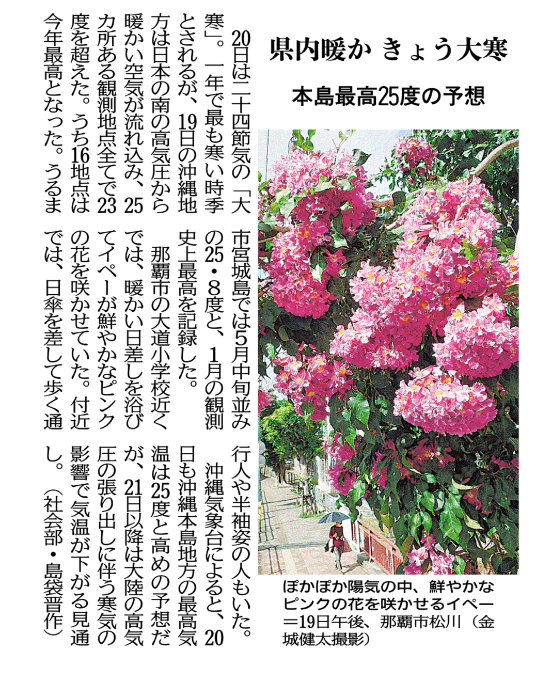
Expected high of 25 degrees Celsius on the main island
Okinawa Times, January 20, 2024
The 20th is the “Daikan,” which is the coldest time of the year according to the 24 solar terms, but today, on the 19th, warm air from a high-pressure system to the south of Japan flowed into the Okinawa area, and the temperature exceeded 23 degrees Celsius at all 25 observation sites. Sixteen of these locations recorded their highest temperatures of this year. Miyagi Island in Uruma City recorded the highest January temperature ever recorded at 25.8 degrees, about the same as mid-May.
Near Daido Elementary School in Naha City, bright pink flowers were blooming on Ipe trees in the warm sunshine. Nearby, passersby were walking with parasols and some people were wearing short sleeves. According to the Okinawa Meteorological Observatory, the highest temperature in the main island of Okinawa is expected to reach 25 degrees on the 20th, but then temperatures will drop from the 21st onwards due to the effects of cold air caused by an extended high pressure system on the Asian mainland.
(Shinsaku Shimabukuro, Social Affairs Department)
Okinawa Times, January 20, 2024
The 20th is the “Daikan,” which is the coldest time of the year according to the 24 solar terms, but today, on the 19th, warm air from a high-pressure system to the south of Japan flowed into the Okinawa area, and the temperature exceeded 23 degrees Celsius at all 25 observation sites. Sixteen of these locations recorded their highest temperatures of this year. Miyagi Island in Uruma City recorded the highest January temperature ever recorded at 25.8 degrees, about the same as mid-May.
Near Daido Elementary School in Naha City, bright pink flowers were blooming on Ipe trees in the warm sunshine. Nearby, passersby were walking with parasols and some people were wearing short sleeves. According to the Okinawa Meteorological Observatory, the highest temperature in the main island of Okinawa is expected to reach 25 degrees on the 20th, but then temperatures will drop from the 21st onwards due to the effects of cold air caused by an extended high pressure system on the Asian mainland.
(Shinsaku Shimabukuro, Social Affairs Department)
(January 29th, 2024)
Editor’s Picks
-

#191 Steadily Evolving EM Nature Farming Method at the Blue Sky Palace -
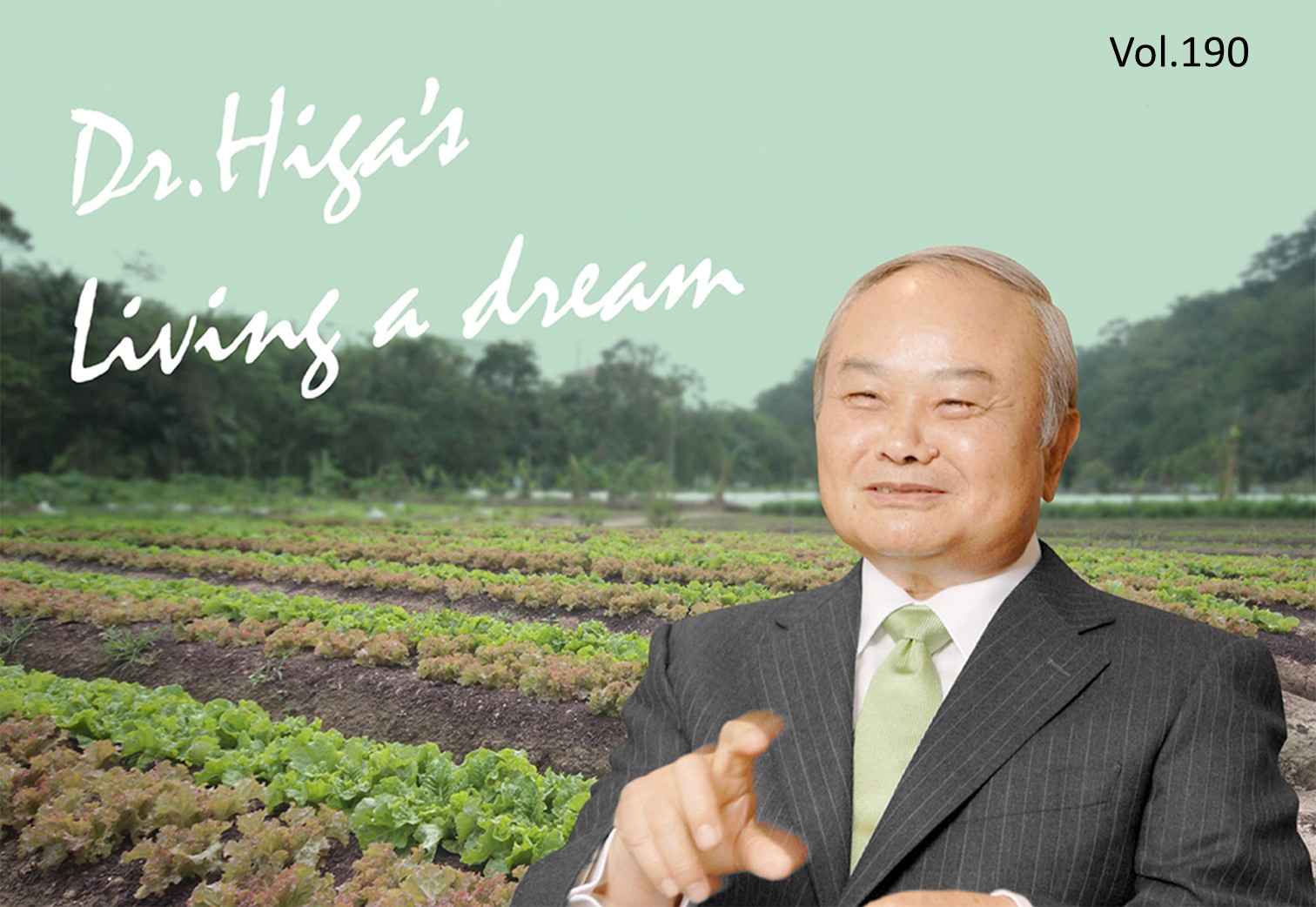
#190 Quantum Mechanical Effects of EM Gravitron Charcoal -
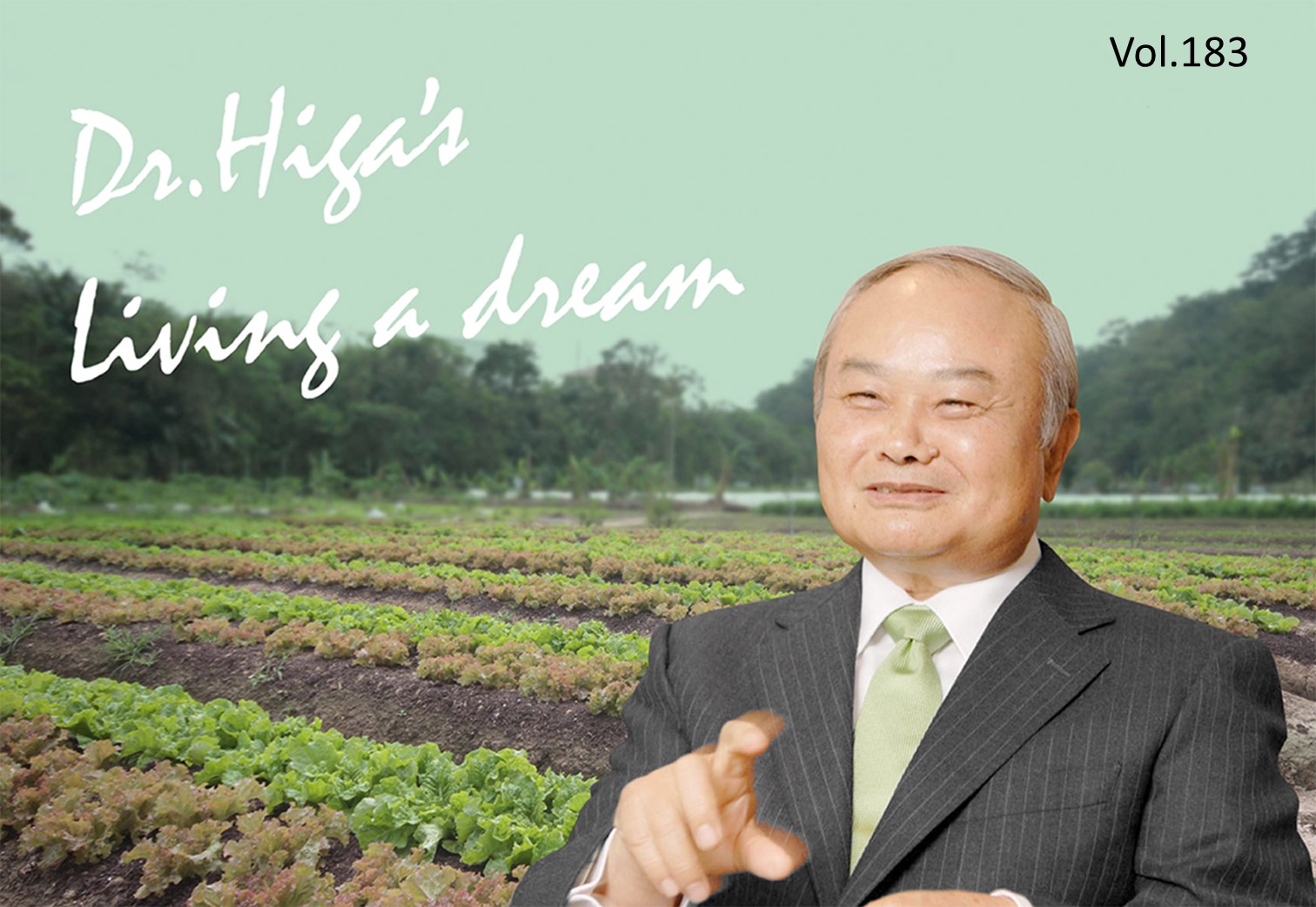
#183 Trial and Error at the Blue-Sky Palace, Part 3 -
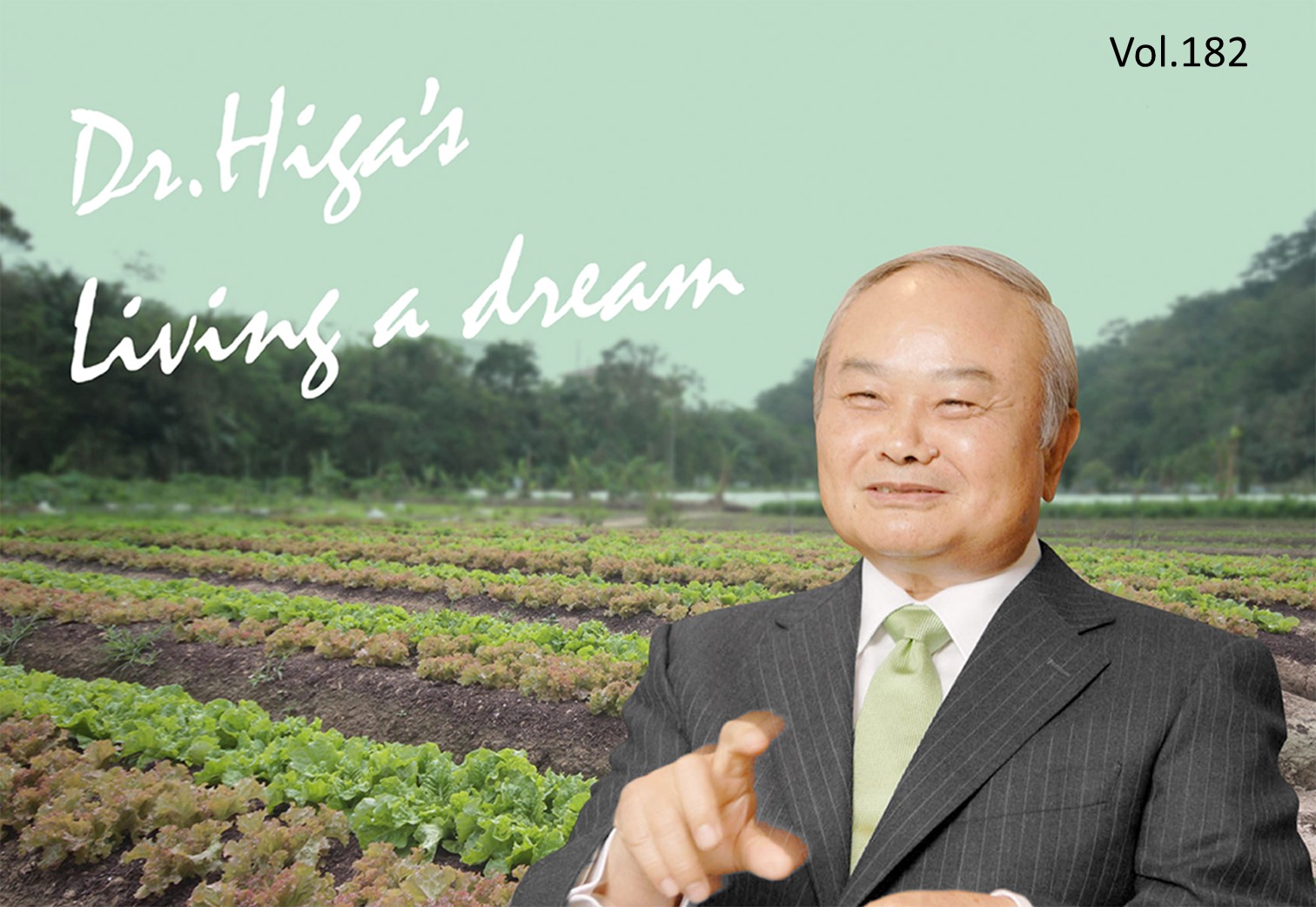
#182 Trial and Error at the Blue-Sky Palace, Part 2
- 2024
- 2023
- Oct:#187 Supermassive Typhoon No.6 and Subsequent Typhoon No. 11
- Sep:#186 Massive Typhoon No.6 that swallowed the Ryukyu Islands Graviton barrier
- Sep:#185 August 8th is World “EM Mudball Day”
- Aug:#184 A disease-free life depends on the health of the intestinal microbiome.
- Jul:#183 Trial and Error at the Blue-Sky Palace, Part 3
- Jun:#182 Trial and Error at the Blue-Sky Palace, Part 2
- Apr:#181 Trial and Error at the Blue-Sky Palace
- Mar:#180 Ala Wai Canal Cleanup Project in Waikiki, Hawaii
- Feb:#179 High-Yield, High-Quality Rice Production Using EM
- Feb:#178 The Progress the "Soil Preparation Workshop" of the Oishi 3-chan Club (Part 2)
- Jan:#177 Organic Farming Instructional Manual Using EM
- 2022
- Nov:#176 The Typhoon Situation in Okinawa in 2022
- Sep:#175 Third-Party Verification of the Graviton barrier in Okinawa Part-2
- Sep:#174 Third-Party Verification of the Graviton barrier in Okinawa
- Aug:#173 Ecosystem Changes Observed in Okinawa in 2021 Part-5
- Jun:#172 Ecosystem Changes Observed in Okinawa in 2021 Part-4
- May:#171 Ecosystem Changes Observed in Okinawa in 2021 Part-3
- Apr:#170 Ecosystem Changes Observed in Okinawa in 2021 Part-2
- Mar:#169 Koizumi Farm in Kamakura Continues to Evolve
- Feb:#168 Ecosystem Changes Observed in Okinawa in 2021 Part-1
- 2021
- Dec:#167 Enjoying EM Technology While Enriching the Local Ecosystem
- Nov:#166 A Case Study of the Use of EM in a Next Generation Free School in Tune with the Cycles of Nature
- Oct:#165 Typhoon conditions and flowers in Okinawa from August to October
- Sep:#164 Re-learning the origins of river purification using EM Cleaning up the Dairyuji River in Senami (Murakami City, Niigata Prefecture)
- Aug:#163 Measures Against Natural Disasters and Re-learning the Starting Point of EM
- Jul:#162 Summary of FFC (Foods for Children) Okinawa Forum 2021
- Jun:#161 Restoring the Vigor of an Old Tree and Purifying the Environment with EM Technology That Even an Amateur Can Do
- May:#160 The Public is Beginning to Recognize the Use of EM Smokeless Carbonizers
- Apr:#159 EM Hado (EM Graviton) that exerts quantum superposition effect over time
- Mar:#158 Virus-free Okinawan Plants Through Use of an EM Graviton Barrier
- Jan:#157 Enjoyable Farming for Self-Sufficiency that Even Amateurs Can Do
- 2020
- Dec:#156 EM quantum energy effect occurring in Okinawa
- Nov:#155 Implementing EM graviton farming as a flood countermeasure for apple orchards
- Oct:#154 The Latest Book on the Practical Uses of EM "You Are the One Who Draws Out the Power of Microorganisms," by Chizuko Nomoto
- Sep:#153 Application of EM technology to long periods of rain, lack of sunshine, storms, heavy rains, etc.
- Aug:#152 EM application in Kitanakagusuku village plant waste recycling yard
- Jul:#151 Natural Disaster Countermeasures Using EM Technology: Part 2
- Jul:#150 Natural Disaster Countermeasures Using EM Technology
- May:#149 How to make your home and workplace an energy spot by living a complete EM lifestyle: creating the ultimate source of health and environmental purification
- Apr:#148 EM, Viruses and the Pandemic
- Apr:#147 New agriculture applying quantum mechanics Part 2
- Apr:#146 New agriculture applying quantum mechanics
- Apr:#145 Wonderful EM Miracle
- 2019
- Nov:#144 The movie “Revival II” and the reality of Fukushima
- Oct:#143 Boundary dome and foliar spraying of EM・X GOLD and EM 3
- Oct:#142 Kirakira (Sparkling) Summer Vegetable Festa in 2019
- Aug:#141 Excessive salt inevitably causes salt damage
- Jul:#140 Diverse applications of charcoal Part 3
- Jun:#139 Diverse applications of charcoal Part 2
- Jun:#138 Diverse applications of charcoal
- Jun:#137 Purification power of salt
- May:#136 The degree of soil contamination is a reflection of the microflora
- May:#135 Definitive use of EM barriers to deal with typhoons
- May:#134 Implementing authentic Nature Farming
- May:#133 How to enhance healthy Hado (wave energy) by EM
- May:#132 Eating Dirt (Soil)
- May:#131 Hado (Wave energy) involved in health
- May:#130 Reaffirming EM technology to realize the essence of agriculture
- May:#129 The 2nd EM Producer Networking Meeting
- Apr:#128 Understanding the application of seawater and salt in crop cultivation
- Apr:#127 Prevention of Disasters by EM Technology
- Mar:#126 Quantum overlay effective utilization of EM
- Jan:#125 EM Disaster Recovery Support Projects in 2017
- 2018
- 2017
- Aug:#121 Escape from conventional agricultural traps
- Jul:#120 Limitation and important caveats regarding utilization of salt
- Jun:#119 EM Technology to Break Through the Limits of Pesticide-Free Strawberries
- May:#118 Application of barriers using EM rectification force
- Apr:#117 The 1st EM Produce Growers' Networking Conference
- Mar:#116 Sumizo kun: The Ultimate Versatile Carbonization Equipment
- Feb:#115 How to make and use simple carbonized and rectified ash
- Jan:#114 Achievements of 2016
- 2016
- Dec:#113 Definitive Measures Against Typhoons
- Nov:#112 International Conference on Universal Village
- Oct:#111 90% of Your Body is Microbes
- Sep:#110 Disaster Countermeasures Using EM
- Aug:#109: Changes in the Natural Environment by EM Barrier Domes in Okinawa
- Jul:#108: Multi-purpose Utilization of Activated EM with Seawater and Salt
- Jun:#107: Marine Day, when EM Mudballs and Activated EM are Applied Throughout Japan
- May:#106: The Function of EM and Gravitational Waves–Part 3
- Apr:#105: The Function of EM and Gravitational Waves–Part 2
- Feb:#104: The Function of EM and Gravitational Waves
- Feb:#103: The Importance of Phototrophic Bacteria in EM
- 2015
- Dec:#102: Results of Environmental Forum "Utsukushima EM Paradise" 2015
- Nov:#101: Environmental Forum "Utsukushima EM Paradise" 2015
- Oct:#100: A New Phase of Limit Breakthrough Using EM
- Sep:#99: A New Phase of Limit Breakthrough through EM
- Aug:#98: The Tokyo Bay Area Began Creating a Truly Livable Hometown
- Jul:#97: Rectifying Effects of EM
- Jun:#96: Lake Suwa Sousei lecture
- May:#95: In Order to Further Ensure Limit Breakthrough
- Apr:#94: Theatrical Release of the Documentary Film SOSEI-Revival to Enlighten People on the New Possibilities of Microorganisms
- Mar:#93: What Underlies Limit Breakthrough (Part 2)
- Feb:#92: EM Functions to Break Through Limits
- Jan:#91: At the Start of 2015
- 2014
- Dec:#90: Looking Back at 2014
- Nov:#89: Shikoku EM FESTA 2014, Virtuous Circle Conference in Matsuyama, Ehime Prefecture
- Oct:#88: Using EM to Deal with Weather Disasters (Part 2)
- Sep:#87: Current Status of Radioactivity Measures Using EM in Fukushima
- Aug:#86: APNAN (Asia Pacific Natural Agriculture Network) 25th Anniversary Conference in 2014
- Jul:#85: Using EM to Deal with Weather Disasters
- Jun:#84: Substantial Improvement of Soil
- May:#83: The Energy Rectification Force of EM
- Apr:#82: The Annual 18th EM Technology Exchange Meeting and Tohoku Conference in Shichigahama
- Mar:#81: Salmon going upstream in Kitaura (Kasumigaura)
- Feb:#80: The Microbiome Again
- Jan:#79: Inauguration of the Federation of Diet Members Who Use and Apply Effective Microorganisms
- 2013
- Dec:#78: Receiving an Honorary Doctoral Degree from Rajamangala University of Technology in Thailand
- Nov:#77: The Use of EM in School Education in Bhutan
- Oct:#76: Well of Bonding
- Sep:#75: The Background to EM Not Being Employed by Public Institutions to Deal with Radiation
- Aug:#74: Dealing with Disaster: Using EM in Crisis Management
- Jul:#73: EM Events on Ocean Day
- Jun:#72: Using EM to Deal With Heat Stroke and Summer Heat Fatigue
- May:#71: An EM Model Town in Malaysia
- Apr:#70: Steps the Japanese Government is Taking to Deal with Radiation: Are They Really Safe?
- Mar:#69: EM Group Disaster Reconstruction Aid Project in Fukushima
- Feb:#68: EM and Microbiomes (Microbial Flora)
- Jan:#67: A Necessary Evil is Still Evil
- 2012
- Dec:#66: The 17th National EM Technology Exchange Conference / Hokkaido Conference in Sapporo
- Nov:#65: EM Forum 2012 in Okinawa and the Environmental Forum in Fukushima
- Oct:#64: 2012 EM Forum
- Sep:#63: A New Earth Saving Revolution
- Aug:#62: The Asahi Newspaper’s Misguided Reports About EM
- Jul:#61: Using EM in Radioactive Contamination Measures in Fukushima Prefecture
- Jun:#60: The Effects of Using EM to Inhibit the Absorption of Radioactivity as Confirmed in Fukushima
- May:#59: Recovery Support for the Great East Japan Earthquake
- Apr:#58: The Royal Kingdom of Thailand, in which EM Functions as a Set Government Policy
- Mar:#57: Report on the Measures Taken by Kingdom of Thailand Using EM to Deal with Polluted Water
- Feb:#56 EM™ as Part of National Policy in Thailand to Deal with Sanitation Issues Resulting from the Flood of 2011
- Jan:#55 The Law of Syntropy (Revitalization)
- 2011
- Dec:#54 EM Forum 2011
- Nov:#53 Shikoku EM Festa 2011- Zenjunkan no Wa (Virtuous Circle) Tokushima Conference in Naruto -
- Oct:#52 The Mystery of Interim Safety Values for Radioactive Material
- Sep:#51 Successful Radiation Countermeasures Using EM
- Aug:#50 Events on Sea Day in which EM Mud Balls are Thrown into the Water and Activated EM is Applied.
- May:#47 Dealing with the Damage Caused by the Eastern Japan Earthquake
- Apr:#46 Eastern Japan Earthquake
- Mar:#45 The 16th National EM Technology Hokuriku Conference in Fukui
- Feb:#44 More Thoughts on Avian Influenza and Foot-and-Mouth Disease
- Jan:#43 Happy New Year!
- 2010
- Dec:#42 Shikoku EM FESTA 2010・Zenjunkan no wa (Virtuous Circle) Fellowship Conference in Tobe, Ehime Prefecture
- Nov:#41 EM Forum 2010
- Oct:#40: My Thanks to the EM™ Volunteers Who Helped in the Fight Against Foot-and-Mouth Disease in Miyazaki Prefecture
- Sep:#39 International EM Mud Ball Day
- Jul:#37 Poland EM Forum 2010
- Jun:#36 EM Countermeasures Against Foot-and-Mouth Disease
- May:#35 Abnormal Weather
- Apr:#34 EM Activities in Thailand: Finding Solutions to the Challenges Facing the Nation
- Mar:#33 New Developments in the Evolution of EMTM in Thailand
- Feb:#32 Results Starting to Be Seen at the Mikasa Project
- Jan:#31 Towards an EM-Use Society
- 2009
- Dec:#30 EM Summit
- Nov:#29 The System in Penang State in Malaysia that Made the World EMTM Mudball Day a Success
- Oct:#28 The "World EM Mudball Day" in Malaysia
- Sep:#27 Validating EMTM Medicine: Case Study Reports from EM Users 2009. (Part 3)
- Sep:#26 Validating EMTM Medicine: Case Study Reports from EMTM Users 2009. (Part 2)
- Jul:#25 Validating EMTM Medicine: Case Study Reports from EMTM Users 2009. (Part 1)
- Jun:#24 Activities to Disseminate EM-Focused Nature Farming in China
- May:#23 Use of EMTM in Response to Swine Flu
- Apr:#22 Using EM to Solve Public Administrative Costs
- Mar:#21 Reaffirming the Versatility of EM
- Jan:#20 The Beginning of a New Era
- 2008
